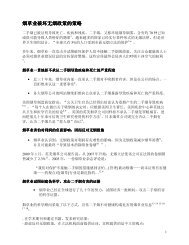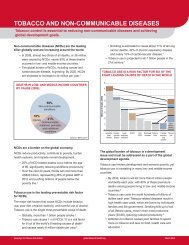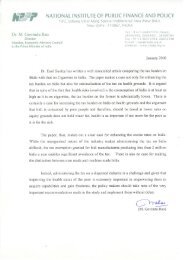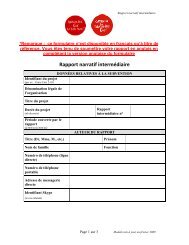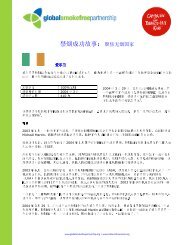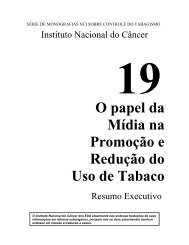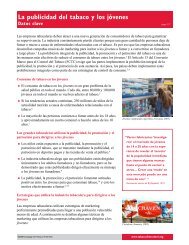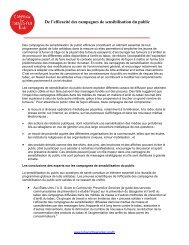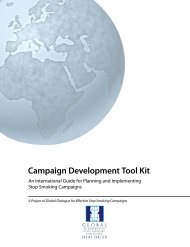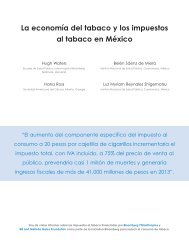Tobacco Taxes in China - Campaign for Tobacco-Free Kids
Tobacco Taxes in China - Campaign for Tobacco-Free Kids
Tobacco Taxes in China - Campaign for Tobacco-Free Kids
Create successful ePaper yourself
Turn your PDF publications into a flip-book with our unique Google optimized e-Paper software.
<strong>Tobacco</strong> <strong>Taxes</strong> <strong>in</strong> Ch<strong>in</strong>a<br />
<strong>Tobacco</strong> <strong>Taxes</strong> <strong>in</strong> Ch<strong>in</strong>a are Low and<br />
Inefficient<br />
There are several types of tax on tobacco <strong>in</strong> Ch<strong>in</strong>a.<br />
• Cigarette tax: The cigarette tax comb<strong>in</strong>es an ad<br />
valorem tax and a specific excise tax. The ad valorem<br />
tax is currently two tiered, allow<strong>in</strong>g producers to<br />
adjust brand prices to pay lower tax rates. The total<br />
cigarette tax rate <strong>in</strong> Ch<strong>in</strong>a is approximately 40%* at<br />
the retail price level, far below the median range of tax<br />
rates of the <strong>in</strong>ternational community, which is between<br />
65 and 70%.<br />
<strong>Tobacco</strong> <strong>Taxes</strong> Save Lives and Increase<br />
Government Revenue<br />
If Ch<strong>in</strong>a raised their tax rate from its current rate to<br />
51% of retail price (via a 1 RMB <strong>in</strong>crease <strong>in</strong> the specific<br />
excise tax per pack), the number of smokers would<br />
decrease and health would improve. <strong>Tobacco</strong> tax revenue<br />
would <strong>in</strong>crease to RMB 235.1 billion ($28.7 billion USD)<br />
— an <strong>in</strong>crease of RMB 64.9 billion.<br />
Table 1: Impact of Cigarette Tax Increase of<br />
1 RMB (-.05 elasticity)<br />
Figure 2: Tax Rates <strong>in</strong> Ch<strong>in</strong>a and Neighbor<strong>in</strong>g<br />
Jurisdictions<br />
Reduction <strong>in</strong> number of smokers<br />
13.7 million<br />
S<strong>in</strong>gapore<br />
Philipp<strong>in</strong>es<br />
Thailand<br />
Hong Kong SAR<br />
Korea<br />
Ch<strong>in</strong>a<br />
40%<br />
63%<br />
63%<br />
60%<br />
60%<br />
69%<br />
0 10 20 30 40 50 60 70 80<br />
Tax rate as a percent of retail price<br />
• <strong>Tobacco</strong> leaf tax: As the only legitimate buyer of<br />
tobacco leaf, CNTC provides a 20% tobacco leaf<br />
tax to local governments as tax revenue. CNTC sets<br />
quotas on production of tobacco leaf. The current tax<br />
revenue shar<strong>in</strong>g mechanism between central and local<br />
governments acts as an <strong>in</strong>centive to encourage local<br />
governments to over-produce tobacco leaf.<br />
The Case <strong>for</strong> Excise Tax Increase<br />
A specific excise tax, by limit<strong>in</strong>g brand switch<strong>in</strong>g to<br />
cheaper cigarettes, is effective <strong>in</strong> reduc<strong>in</strong>g smok<strong>in</strong>g<br />
prevalence. In contrast, ad valorem excise taxes lead to<br />
a greater spread <strong>in</strong> prices between cheaper and higherpriced<br />
cigarettes, <strong>in</strong>creas<strong>in</strong>g the potential <strong>for</strong> switch<strong>in</strong>g<br />
to cheaper cigarettes when excise rates are <strong>in</strong>creased and<br />
underm<strong>in</strong><strong>in</strong>g the public health benefit of tobacco taxation.<br />
Specific excise taxes are easier to adm<strong>in</strong>ister because it is<br />
only necessary to determ<strong>in</strong>e the physical quantity of the<br />
product taxed and not its value.<br />
Lives saved<br />
Medical cost sav<strong>in</strong>gs<br />
Increase <strong>in</strong> tobacco tax revenue<br />
3.4 million<br />
RMB 2.68 billion<br />
RMB 64.9 billion<br />
• Productivity losses would decrease, generat<strong>in</strong>g<br />
an additional 9.92 billion ($1.2 billion USD) <strong>in</strong> the<br />
Ch<strong>in</strong>ese economy.<br />
• Projected <strong>in</strong>dustry losses of 1.63 billion RMB would<br />
be negligible compared to the ga<strong>in</strong> <strong>in</strong> government tax<br />
revenue.<br />
• Employment losses, at approximately 5,500<br />
employees, would be m<strong>in</strong>imal compared with the loss<br />
of 59,000 employees due to mergers and efficiencies <strong>in</strong><br />
the Ch<strong>in</strong>ese tobacco <strong>in</strong>dustry.<br />
• <strong>Tobacco</strong> farmers could lose 6% of their total revenue,<br />
or RMB 873 million. However, farmers could use the<br />
land to produce other more profitable crops and thus<br />
potentially <strong>in</strong>crease earn<strong>in</strong>gs.<br />
• The local governments could lose RMB 174.53<br />
million. However, these local government revenue<br />
losses could be easily compensated <strong>for</strong> by the<br />
<strong>in</strong>creased central government tax revenue.<br />
*The precise total tax rate as a percent of retail price is uncerta<strong>in</strong>, but is estimated to be between 32 and 40 percent.



